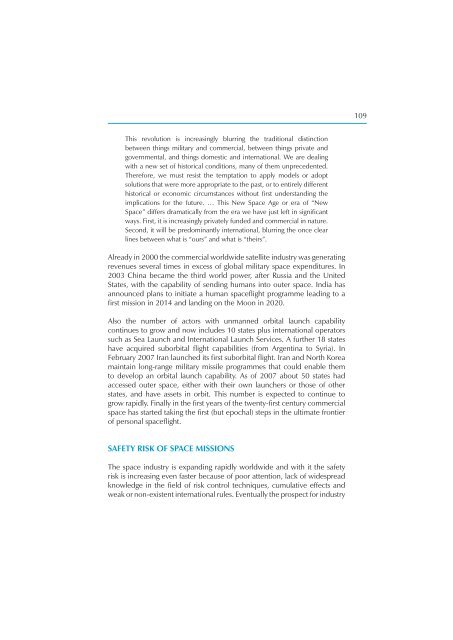Security in Space The Next Generation - UNIDIR
Security in Space The Next Generation - UNIDIR
Security in Space The Next Generation - UNIDIR
Create successful ePaper yourself
Turn your PDF publications into a flip-book with our unique Google optimized e-Paper software.
This revolution is <strong>in</strong>creas<strong>in</strong>gly blurr<strong>in</strong>g the traditional dist<strong>in</strong>ction<br />
between th<strong>in</strong>gs military and commercial, between th<strong>in</strong>gs private and<br />
governmental, and th<strong>in</strong>gs domestic and <strong>in</strong>ternational. We are deal<strong>in</strong>g<br />
with a new set of historical conditions, many of them unprecedented.<br />
<strong>The</strong>refore, we must resist the temptation to apply models or adopt<br />
solutions that were more appropriate to the past, or to entirely different<br />
historical or economic circumstances without fi rst understand<strong>in</strong>g the<br />
implications for the future. … This New <strong>Space</strong> Age or era of “New<br />
<strong>Space</strong>” differs dramatically from the era we have just left <strong>in</strong> signifi cant<br />
ways. First, it is <strong>in</strong>creas<strong>in</strong>gly privately funded and commercial <strong>in</strong> nature.<br />
Second, it will be predom<strong>in</strong>antly <strong>in</strong>ternational, blurr<strong>in</strong>g the once clear<br />
l<strong>in</strong>es between what is “ours” and what is “theirs”.<br />
Already <strong>in</strong> 2000 the commercial worldwide satellite <strong>in</strong>dustry was generat<strong>in</strong>g<br />
revenues several times <strong>in</strong> excess of global military space expenditures. In<br />
2003 Ch<strong>in</strong>a became the third world power, after Russia and the United<br />
States, with the capability of send<strong>in</strong>g humans <strong>in</strong>to outer space. India has<br />
announced plans to <strong>in</strong>itiate a human spacefl ight programme lead<strong>in</strong>g to a<br />
fi rst mission <strong>in</strong> 2014 and land<strong>in</strong>g on the Moon <strong>in</strong> 2020.<br />
Also the number of actors with unmanned orbital launch capability<br />
cont<strong>in</strong>ues to grow and now <strong>in</strong>cludes 10 states plus <strong>in</strong>ternational operators<br />
such as Sea Launch and International Launch Services. A further 18 states<br />
have acquired suborbital fl ight capabilities (from Argent<strong>in</strong>a to Syria). In<br />
February 2007 Iran launched its fi rst suborbital fl ight. Iran and North Korea<br />
ma<strong>in</strong>ta<strong>in</strong> long-range military missile programmes that could enable them<br />
to develop an orbital launch capability. As of 2007 about 50 states had<br />
accessed outer space, either with their own launchers or those of other<br />
states, and have assets <strong>in</strong> orbit. This number is expected to cont<strong>in</strong>ue to<br />
grow rapidly. F<strong>in</strong>ally <strong>in</strong> the fi rst years of the twenty-fi rst century commercial<br />
space has started tak<strong>in</strong>g the fi rst (but epochal) steps <strong>in</strong> the ultimate frontier<br />
of personal spacefl ight.<br />
SAFETY RISK OF SPACE MISSIONS<br />
<strong>The</strong> space <strong>in</strong>dustry is expand<strong>in</strong>g rapidly worldwide and with it the safety<br />
risk is <strong>in</strong>creas<strong>in</strong>g even faster because of poor attention, lack of widespread<br />
knowledge <strong>in</strong> the fi eld of risk control techniques, cumulative effects and<br />
weak or non-existent <strong>in</strong>ternational rules. Eventually the prospect for <strong>in</strong>dustry<br />
109








